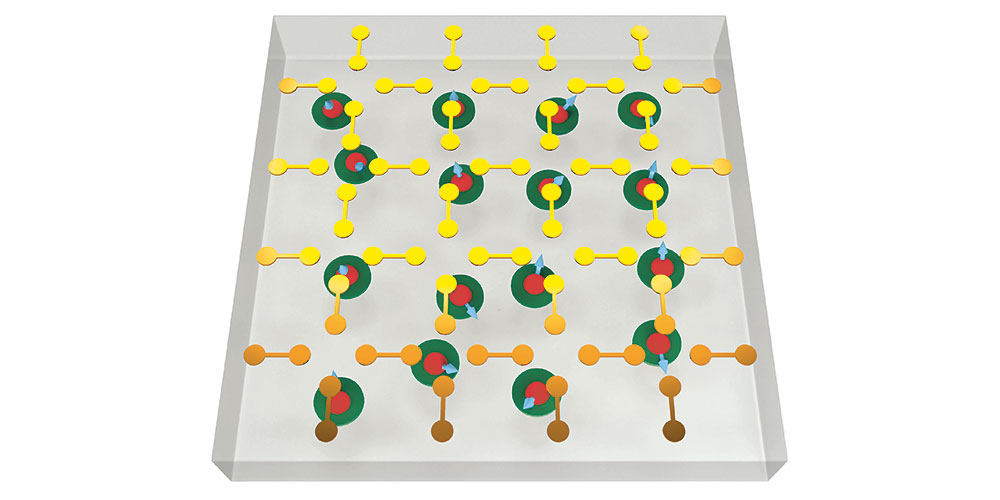Silicon for the super computer.
Text: Leonid Leiva
Today’s modern computers rely on silicon chips. Researchers from Basel are convinced that this material will also prove its worth in the development of powerful quantum computers.
One day, quantum computers will solve mathematical challenges far beyond the capabilities of today’s computers, but it remains unclear what such a super computer will look like. For instance, we don’t yet know the material of the quantum bits (short: qubits) that carry the information. There are some candidates whose development is quite advanced, such as qubits consisting of superconducting rings, or atoms (ions) that are suspended in laser light. Yet these methods have one fundamental flaw: Any viable computer with millions of bits would end up being far too large. “Limited scalability could become a dead end for these approaches,” says physicist Professor Richard Warburton.
Warburton and colleagues at the University of Basel therefore want to pursue a different path, which has worked well for traditional computers: They believe silicon could be the right material for qubits. They are encouraged by recent scientific breakthroughs as well as an increasing interest on the part of key corporate players, which make the semiconductor seem a realistic option for quantum computers. “The timing is perfect,” Warburton says, pointing out that Intel, the global leader in computer chip production, has been working on the development of silicon qubits with Dutch scientists since 2015, investing approximately CHF 50 million.
Production processes for silicon are well established; the computer industry knows this material better than any other. Silicon chips have evolved dramatically over the span of decades – confirming Intel-founder Gordon Moore’s prediction that the number of transistors per surface unit on a chip would double every 18 months. To achieve today’s information density, individual bits cannot be spaced out more than 10 to 100 nanometers (billionths of a meter), which requires ultra-precise manufacturing methods. Therefore, Warburton and his team want to partner with IBM to build the silicon qubits, harnessing the corporation’s vast experience in nanomanufacturing.
Silicon still lags behind
Experiments using silicon as a material for spin-qubits made a relatively late entrance into quantum computer research. The electron spin in a silicon atom crystal is a fragile carrier of information. Imagine the spin, the electron’s magnetic moment, as a compass needle carried by the electron. The trouble with silicon is that some atomic nuclei – namely, those of the silicon 29 isotope – have their own spin, which influences the electron’s spin. This disruption can be eliminated by removing the silicon 29.
This is why Warburton’s qubits will consist of high-purity silicon, using nanometer-scale structures called quantum dots that greatly restrict an electron’s mobility. Since space is so tight, the electron in the quantum dot behaves similarly to when it is bound to an atom. Quantum dots are also called “artificial atoms” because the electrons inside them can only assume certain states, rendering the information that is coded into the electrons much more controllable.
A quantum computer can only work if several qubits are interconnected. Due to this quantum-mechanical phenomenon, any change or measurement of the state of one qubit will immediately impact the qubits that are connected to it. Interconnection therefore means that two or more qubits are so closely coupled to one another that it impossible to disturb one without also impacting its partners. Establishing and maintaining this coupling is a major challenge.
Connected via a “double-bladed paddle”
Electron spins can be interconnected directly via their magnetic fields. That only works if they are very close together, for the forces of the electron spins lose most of their power even over very short distances. Also, arranging the qubits close together would create another issue: There would be no more room on the chip for switches and circuits. Spacing the qubits further apart would remedy this problem, but then the direct interaction between electron spins would not be strong enough to couple the qubits. Harnessing electro-static forces could be an alternative way to interconnect the qubits, and that is exactly what Richard Warburton and his team of researchers in Basel are trying to achieve. The idea, proposed by fellow Basel-based physicist Daniel Loss and his team in 2012, involves a specially shaped metal wire called a “floating gate” that looks like a double-bladed paddle. This floating gate is supposed to interconnect the spins of both electrons – and thus make silicon qubits possible.
A step towards miniaturization
Warburton is convinced that electric controls and interconnected qubits will overcome the greatest obstacle in the development of quantum computers – the problem of scalability. We already have functioning quantum computers today, but existing models feature only a dozen interconnected qubits. To make real strides in quantum computer technology, the number of qubits must increase by several orders of magnitude. Floating gates will take us closer to this goal. The goal of Warburton’s research project at the University of Basel is to prove, among other things, that this kind of electrostatic coupling of spin-qubits is technically feasible. “If we successfully interconnect two qubits in silicon in a controlled manner, it would be a huge step toward a highly miniaturized, powerful quantum computer with millions of interconnected qubits,” Warburton says
More articles in the current issue of UNI NOVA.

